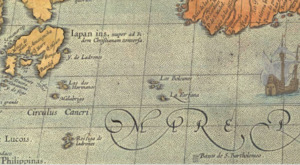Bernardo de la Torre facts for kids
Bernardo de la Torre (died 1545) was a Spanish explorer during the Age of Discovery. This was a time when European countries explored many new parts of the world. He joined an expedition led by Ruy López de Villalobos. Their goal was to make Spain stronger in the East Indies, a region in Southeast Asia.
The expedition faced many problems. They were stuck for months near Mindanao, an island in the Philippines. They ran out of supplies and had accidents. The Portuguese, who were also exploring, told them to leave. Villalobos then sent De la Torre to sail east across the Pacific Ocean. He was supposed to find supplies and help from Spanish Mexico. De la Torre tried a new northern route. He discovered the Volcano Islands, naming them because a volcano was erupting as he passed. He had to turn back because his ship ran low on water and faced big storms. On his way back, his ship was the first known to sail all the way around Mindanao.
Some people also say that De la Torre named Mindanao "Caesarea Caroli" after Emperor Charles V. They also say he named Leyte and Samar "the Philippines" to honor Prince Philip, who later became King Philip II of Spain. He might have also named Iwo Jima "Sulfur Island," which led to its Japanese name. He may have also discovered the Bonin Islands and explored the northern coast of New Guinea.
Life of Bernardo de la Torre
We do not have the original stories of De la Torre's life and travels. The four stories that do exist from around that time are a bit different and have some mistakes.
Bernardo de la Torre began his journey in August 1543. He sailed on a ship called the San Juan de Letran. Ruy López de Villalobos sent him from the Sarangani Islands. De la Torre's mission was to find a way back to the western coast of Spanish Mexico from the Philippines. This was the fourth try to find this route. It later became known as the Manila galleon route, which was finally found in 1565. De la Torre sailed as far north as 30 degrees latitude. But like the explorers before him, he had to turn back because of bad storms.
During his trip, De la Torre found some small islands. These included modern-day Okinotorishima, which he called Parece Vela. He might have also found Marcus Island. He reached Leyte and Samar islands before the end of August. In September, he sailed through the Marianas. He saw three islands there. These were probably the northern islands of Farallon, Anatahan, and Sarigan, which were not lived on. He then passed the Volcano Islands group, which he called Los Volcanes. This group includes Iwo Jima. He also saw some of the Bonin Islands, which he called the Islas del Arzobispo (Archbishop Islands). One of these was Chichijima, which he called Farfama.
On October 18, a storm forced him to turn back. His ships and supplies were in bad shape. On his way back, he became the first European to sail all the way around Mindanao. The Portuguese had forced Villalobos to leave the area. De la Torre had to search for them without success. He eventually went to Tidore for ship repairs.
His explorations were mentioned in a book by Juan de Gaetano. This book was written in 1546 and was called Viaje a las Islas de Poniente ("Voyage to the Islands of the West").
Legacy of Bernardo de la Torre
Some stories say that Bernardo de la Torre was the one who changed the name of the "Islands of the West." He supposedly renamed them the Felipinas, or Philippines. This was to honor Prince Philip, who later became king of Spain. Other stories say that Villalobos was the one who gave the islands this name.
See also
 In Spanish: Bernardo de la Torre para niños
In Spanish: Bernardo de la Torre para niños


